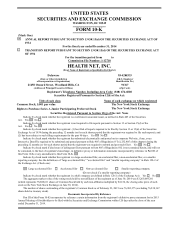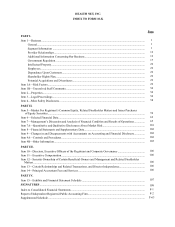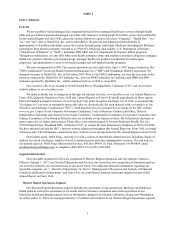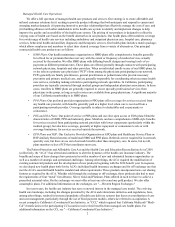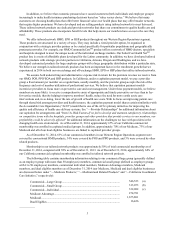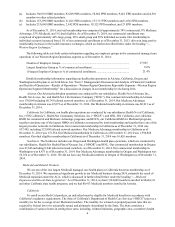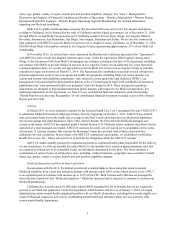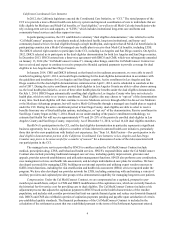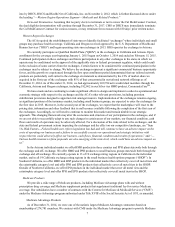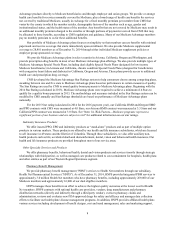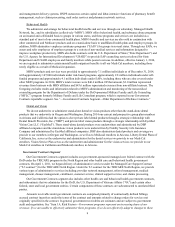Health Net 2014 Annual Report Download - page 7
Download and view the complete annual report
Please find page 7 of the 2014 Health Net annual report below. You can navigate through the pages in the report by either clicking on the pages listed below, or by using the keyword search tool below to find specific information within the annual report.5
status, age, gender, county or region, benefit mix and member eligibility category. See “Item 7. Management's
Discussion and Analysis of Financial Condition and Results of Operations—Results of Operations—Western Region
Operations Reportable Segment—Western Region Operations Segment Membership” for detailed information
regarding our Medicaid enrollment.
Medi-Cal is a public health insurance program that provides health care services for low-income individuals
residing in California, and is financed by the state of California and the federal government. As of December 31, 2014,
through HNCS, we had Medi-Cal operations in 12 California counties: Fresno, Kern, Kings, Los Angeles, Madera,
Riverside, Sacramento, San Bernardino, San Diego, San Joaquin, Stanislaus and Tulare. We are the sole commercial
plan contractor with DHCS to provide Medi-Cal services in Los Angeles County, California. As of December 31, 2014,
848,898 of our Medi-Cal members resided in Los Angeles County, representing approximately 53% of our Medi-Cal
membership.
In November 2012, we entered into a state-sponsored health plans rate settlement agreement (the "Agreement")
with DHCS to settle certain rate disputes related to prior years. Under the Agreement, DHCS agreed, among other
things, to the extension of all of our Medi-Cal managed care contracts existing on the date of the Agreement, including
our contract with DHCS to provide Medi-Cal services in Los Angeles County, for an additional five years from their
existing expiration dates. As a result, our agreement to provide Medi-Cal services in Los Angeles County is currently
scheduled to expire by its terms on March 31, 2019. The Agreement also established an account to track retrospective
premium adjustments on all of our state-sponsored health care programs, including Medi-Cal, which includes our
seniors and persons with disabilities population—also referred to as the aged, blind and disabled (“SPDs”), our
participation in the dual eligibles demonstration portion of the CCI that began in April 2014 and Medi-Cal expansion
populations (our “state-sponsored health care programs”) that also began in 2014. These retrospective premium
adjustments are designed to help maintain minimum pretax margins with respect to our Medi-Cal operations. For
additional information on the Agreement, see Note 2 to our consolidated financial statements, under the heading
"Health Plan Services Revenue Recognition," to our consolidated financial statements included as part of this Annual
Report on Form 10-K.
Arizona
In March 2013, we were awarded a contract by the Arizona Health Care Cost Containment System ("AHCCCS")
to administer Medicaid benefits in Maricopa County, Arizona, beginning on October 1, 2013. AHCCCS uses federal,
state and county funds to provide health care coverage to the State’s acute and long-term care Medicaid populations,
low income groups and small businesses. Since 1982, when it became the first statewide Medicaid managed care
system in the nation, AHCCCS has operated under a federal Section 1115 Medicaid waiver authority that allows for the
operation of a total managed care model. AHCCCS contracts for acute care services in seven geographic service areas
that include 15 Arizona counties. Our contract for Maricopa County has an initial term of three years with two
additional one-year extensions. In accordance with AHCCCS contractual requirements, we established a subsidiary,
Health Net Access, Inc., whose sole activity is to perform the obligations under the AHCCCS contract.
AHCCCS makes monthly prospective capitation payments to contracted health plans responsible for the delivery
of care to members. As with our monthly fee under Medi-Cal, the monthly fee is based on prepaid payment rates that
are required by federal law to be actuarially sound, and ultimately determined by the State. The State considers a
combination of various factors in setting these rates, including, without limitation, geographic area, a member's health
status, age, gender, county or region, benefit mix and member eligibility category.
Medicaid Expansion and Recent State Legislation
In connection with the ACA, the federal government extended funds to those states that opted to expand
Medicaid eligibility from a pool that included residents with incomes up to 100% of the federal poverty level (“FPL”)
to an expanded pool of residents with incomes up to 133% of the FPL. Both Arizona and California are amongst the
states that have opted into this “Medicaid expansion,” which has increased and is expected to continue to increase our
Medicaid membership.
California also recently enacted a bill under which DHCS expanded the list of benefits that we are required to
provide to our Medi-Cal population. Under this legislation, which became effective as of January 1, 2014, we began
administering certain mental health outpatient benefits to all our Medi-Cal members, including those newly eligible as a
result of Medicaid expansion, and closely coordinating mental health and substance abuse services activities with
county mental health departments.

